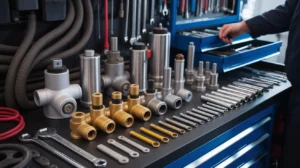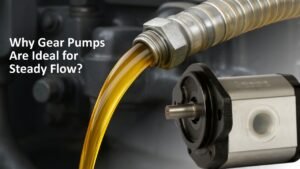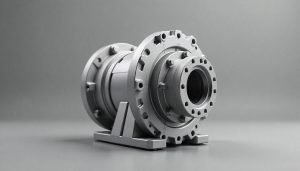Servo systems are widely used in today’s industrial automation, computer numerical control machines, and several other high accuracy operations. Two of the most important elements of these systems are the Servo Drive and the Servo Motor. However, they perform different roles while they are in combination. It is therefore important to understand the difference between the two in order to choose the most appropriate system for industrial use.
In this article, we will attempt to explain the differences between Servo Drives and Servo Motors, how they operate and their uses. This guide will be useful if you are seeking to purchase quality Servo Drives in India.
What is a Servo Motor?
A Servo Motor is a rotary or linear motor that is used to control the speed, position and torque of an application. These motors are generally employed in automation, robotics and in the motion control applications because of ability to perform the functions with great precision and reliability.
Key Features of Servo Motors:
- High Precision: Servo motors are capable of holding position with high degree of precision.
- Fast Response: They provide short-time-to-lunch and short-time-to-brake for high speed uses.
- High Torque Density: However, even with low physical dimensions, servo motors are capable of producing large amounts of torque.
- Closed-Loop Control: Majority of servo motors work with feedback hence allowing real time corrections.
- Energy Efficiency: Intended for low power consumption while at the same time providing high performance.
Different types of servo motors are; AC servo motors, DC servo motors, and brush-less servo motors of which they vary in their uses.
Common Applications of Servo Motors:
– Computer numerical control machinery and milling machines
– Material handling equipment or systems
– Products that need accurate regulation for medical use
What is a Servo Drive?
A Servo Drive, often referred to as a servo amplifier is an electric device that is responsible for the operation of a servo motor. This receives input signals from a PLC or a motion controller and controls the power supplied to the motor to give the required movement, without errors.
Key Functions of a Servo Drive:
1. Power Regulation: Panel 1 shows the 2 servo drives linked to the motors that receive power form the power converter during running of the machine.
2. Feedback Processing: It gets signals from an encoder or resolver and constantly feedbacks the motor performance.
3. Speed and Torque Control: In this way, depending on the application, it controls both the speed and torque of the motor.
4. Error Correction: They include sensing and responding to variations in position or speed, with a view to bringing them back to the target.
5. Communication with Controllers: Servo drives control industrial controllers such as PLCs, to perform accurate motion sequences.
Types of Servo Drives:
- Analog Servo Drives: Use analog signals for control.
- Digital Servo Drives: Digital signals let you control systems more precisely with greater flexibility.
- AC Servo Drives: Designed for AC servo motors.
- DC Servo Drives: Work with DC servo motors.
- Common Applications of Servo Drives:
- Robotics and automation systems
- Printing and textile machinery
- Semiconductor manufacturing
- Industrial conveyors and assembly lines
- Motion control in automotive applications
Servo Drive vs Servo Motor: Key Differences
| Feature | Servo Motor | Servo Drive |
| Function | Converts electrical energy into mechanical motion | Controls and regulates the motor’s movement |
| Primary Role | Provides torque and motion for an application | Adjusts speed, position, and torque based on input signals |
| Power Supply | Receives controlled power from the servo drive | Regulates power from the main source to the motor |
| Feedback Mechanism | Uses an encoder or resolver to send signals to the servo drive | Processes feedback signals and corrects motor performance |
| Control Type | Follows input commands for movement | Provides closed-loop control to ensure precise operation |
| Application | Found in robotics, CNC machines, automation, and more | Used to regulate and optimize servo motor performance |
The servo drive maintains optimized motor operation through power management and speed control with feedback processes while the servo motor delivers actual motion commands.
How Do Servo Motors and Servo Drives Work Together?
1. The Servo Drive obtains command signals from either a PLC or motion controller.
2. The Servo Drive controls electrical power flow to achieve precise current and voltage levels which reach the Servo Motor.
3. The Servo Motor executes commands which trigger feedback signals from the encoders.
4. The Servo Drive analyzes feedback signals to modify power output which keeps the system at the specified position or speed or torque.
The closed-loop system structure delivers both precision and efficiency to industrial automation systems.
Why Choose High-Quality Servo Drives in India?
The increasing need for automated solutions in India requires industries to choose superior servo drives to achieve optimal performance together with enhanced operational efficiency. THM Huade Hydraulics offers premium Servo Drives in India, ensuring:
✔ 100% Authentic Products
✔ Reliable Performance & Durability
✔ High Efficiency & Precision Control
✔ Advanced Motion Control Technology
For servo drive and servo motor selection you need to analyze application requirements together with power needs and compatibility with existing automation equipment.
Conclusion
Industrial motion control depends on Servo Drives and Servo Motors but they work in separate functions. The Servo Motor produces movement and the Servo Drive manages power supply and movement precision. They help create advanced robotic and CNC machine systems that work at top performance levels.
THM Huade Hydraulics in India delivers advanced motion control systems that deliver both reliability and efficiency for your needs. Knowing how these parts differ will let you pick the perfect automation solution for your project.



